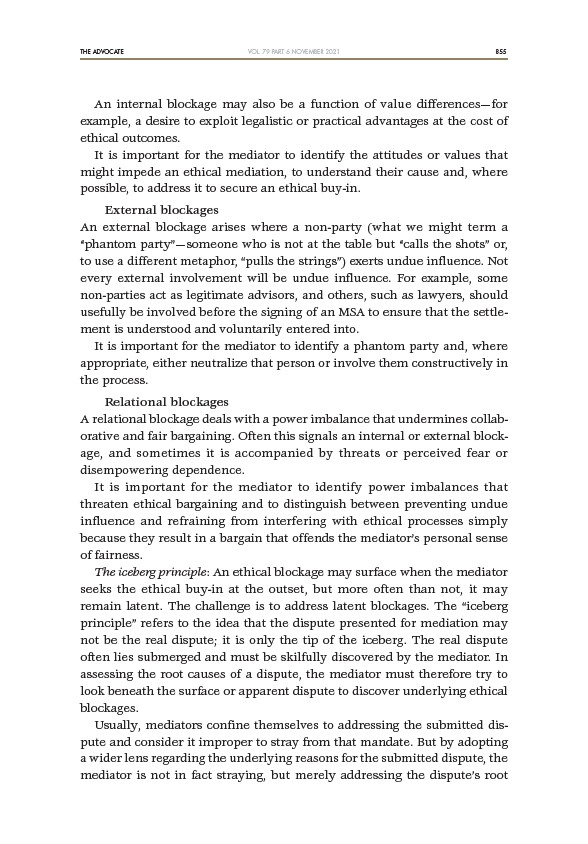
THE ADVOCATE 855
VOL. 79 PART 6 NOVEMBER 2021
An internal blockage may also be a function of value differences—for
example, a desire to exploit legalistic or practical advantages at the cost of
ethical outcomes.
It is important for the mediator to identify the attitudes or values that
might impede an ethical mediation, to understand their cause and, where
possible, to address it to secure an ethical buy-in.
External blockages
An external blockage arises where a non-party (what we might term a
“phantom party”—someone who is not at the table but “calls the shots” or,
to use a different metaphor, “pulls the strings”) exerts undue influence. Not
every external involvement will be undue influence. For example, some
non-parties act as legitimate advisors, and others, such as lawyers, should
usefully be involved before the signing of an MSA to ensure that the settlement
is understood and voluntarily entered into.
It is important for the mediator to identify a phantom party and, where
appropriate, either neutralize that person or involve them constructively in
the process.
Relational blockages
A relational blockage deals with a power imbalance that undermines collaborative
and fair bargaining. Often this signals an internal or external blockage,
and sometimes it is accompanied by threats or perceived fear or
disempowering dependence.
It is important for the mediator to identify power imbalances that
threaten ethical bargaining and to distinguish between preventing undue
influence and refraining from interfering with ethical processes simply
because they result in a bargain that offends the mediator’s personal sense
of fairness.
The iceberg principle: An ethical blockage may surface when the mediator
seeks the ethical buy-in at the outset, but more often than not, it may
remain latent. The challenge is to address latent blockages. The “iceberg
principle” refers to the idea that the dispute presented for mediation may
not be the real dispute; it is only the tip of the iceberg. The real dispute
often lies submerged and must be skilfully discovered by the mediator. In
assessing the root causes of a dispute, the mediator must therefore try to
look beneath the surface or apparent dispute to discover underlying ethical
blockages.
Usually, mediators confine themselves to addressing the submitted dispute
and consider it improper to stray from that mandate. But by adopting
a wider lens regarding the underlying reasons for the submitted dispute, the
mediator is not in fact straying, but merely addressing the dispute’s root